
Home Labs of the Stars
While many already had home lab setups for projects and exploring curiosities, the challenges of the global pandemic have driven many to ramp up their set ups and spend more time at their in-house benches. Over the years, Signal Integrity Journal has worked with many leading industry experts and stars in our field. Some have gamely agreed to play along with me and share images of their home labs. Enjoy the tour!
Jay Diepenbrock, "I like my lab, which is good enough for home and ham radio projects, though I could use a little more space. It's not as well-equipped as my old corporate lab, but it has analog and digital oscilloscopes, an audio generator, a pulse/function generator, power supplies, multimeters, some RF test equipment, and soldering equipment. Someday I'd like to have a decent spectrum analyzer...". Jay is a member of the SIJ Editorial Advisory Board (EAB) and a consultant at SIRF Consultants.
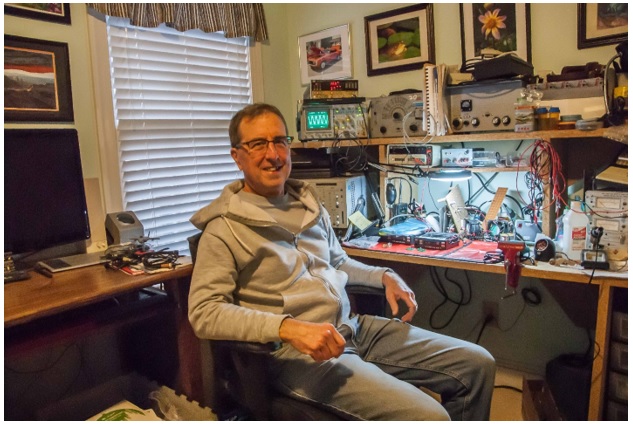
See Heidi Barnes' Lab on Next Page →
Heidi Barnes: “My home lab has been evolving. It started on our dining room table and then with the home office going long term I have been working on moving it to my garage. Also found that some of the older instruments generate a lot of fan noise and heat so best to have it in a room to itself and not at my office desk.” Heidi is a Senior Applications Engineer at Keysight Technologies.

See Bert Simonovich's Lab on Next Page →
Bert Simonovich: “This is part of my cramped home basement lab to aid in PCB forensic analysis and SI model development / validation. Shown in the picture is my Celestron compound microscope, with 5 MP digital microscope camera attached, used to take cross-section photographs and measurements of PCB trace geometries. Equipment I wished I had is: a better reflected light microscope, an 18 MP USB3.0 digital microscope camera, and a Teledyne Lecroy Wavepulser 40iX TDR/S-parameter analyzer with selection of high quality cables and an ample supply of k-connectors.” Bert is a signal integrity/backplane specialist and founder of Lamsim Enterprises.

See Ken Wyatt’s Lab on Next Page →
Ken Wyatt: “As an an active EMC consultant since 2008, I depend on my lab bench and gear to assist my clients in characterizing and troubleshooting EMC issues. This is especially important during this time of pandemic, because many clients prefer to ship me their products to test, rather than have me do this in-house. Currently, the bench includes (left to right) a variety of older HP power supplies, a Siglent SDG 1062X Function/Arbitrary Generator, an Agilent MSO-X 3102A oscilloscope, a Siglent SSA 3032X spectrum analyzer, and down below, a Kikusui PAL 35-10 power supply, Siglent SPD 3303C power supply, a Hakko FX-888D soldering station (excellent, by the way), a Fluke 77 DMM, a Signal Hound VSG25A RF synthesizer, a Tekbox TBMDA3 5W broadband RF power amplifier/modulator and a Rigol DL3021 electronic load.
“If you’re thinking of assembling a home lab, then I’d suggest starting off with a good oscilloscope (maybe 200 to 500 MHz BW), a multi-output power supply like the Siglent SPD 3303C and maybe some sort of affordable function generator similar to the Siglent SDG 1062X. Rigol would also be a good source for these. I also really love the Hakko soldering station - did I already say that? Ha! If doing any RF design, then include one of the affordable Rigol or Siglent spectrum analyzers. If you’re specifically interested in equipment for EMC, then I’d suggest a copy of Create Your Own EMC Troubleshooting Kit - Volume 1, available from Amazon.” Ken is an EMC consultant at Wyatt Technical Services LLC.

See Mike Steinberger's Lab on Next Page →
Mike Steinberger: “Almost all of my work time has been spent in a home office with a desk that I designed and built. The slanted desk top helps with all the paper I use instead of a second monitor, my most valued books are within easy reach, the desk houses three of the four computers I use on a daily basis, and the office contains memorabilia such as the space qualified traveling wave tube on the wall.
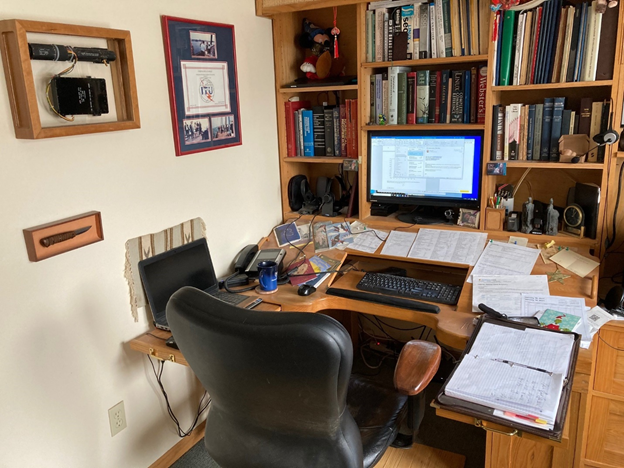

My home lab is the machining/welding/furniture making playpen where I fabricated the experimental samples for ‘A Simple Via Experiment’.” Mike is a lead architect serial channel products at The Mathworks, Inc.
See Steve Sandler's Lab on Next Page →
Steve Sandler: “What I love about my lab: I love that I have such an amazing collection of state-of the art equipment, including IsoVu probes, and multiple stations for analog, digital and RF to 10GHz. I love how organized it is, so it’s always easy to find what I need, and the most frequently used devices are within reach without having to get up from the bench. I have webcam and screen recording capability on both benches.” Steve is a member of the SI Journal EAB and managing director at Picotest.


See Anonymous Engineer’s Lab on Next Page →
Semi-retired Silicon Valley Applications and Systems Engineer that previously worked at Linear Technology, Zoran, National Semiconductor, and Texas Instruments: “This photo is of the "good stuff" in my home lab. Many other items of my home lab are not shown as they just won't fit on that side of the room. If I turn on any additional instruments for this photo, the breaker trips!
Cabinets from right to left:
1st: Miscellaneous VNAs and FRAs Bode 100 and injector kit from Picotest in center stage!
2nd: RF Rohde &Schwarz plus an interloping Anritsu. Symmetricom 10MHz master reference oscillator and GPS disciplined setup still need to be plumbed in.
3rd: Scopes from: R&S 4GHz RTO1044 including Logic Analyzer option; LeCroy 1GHz HDO6104 12bit; LeCroy 1GHz HDO8108 12bit with logic analyzer option; numerous AC/DC current probes from LeCroy and Tek not shown.
4th: Audio Analyzers aplenty. Sound Technology, Audio Precision SYS-2722, R&S UPV, Tek AM700, Audio Precision ATS1 &2
5th: Semiconductor Analysis with thermal chamber on top; HP4145B w/plotter; Keithley 590 CV analyzer and 237 HV SMU.
6th: DC precision rack. With Fluke Voltage Standard on top. Then 4 seven decade Kelvin Varley dividers from Fluke and ESI and 3 HP 3458A 8-1/2 digit bench meters. (3 of them permits voting...)
My advice on shopping for high end gear? Shop wisely. Purchase new gear in the last week of a supplier’s fiscal quarter. And buy factory demo units or the previous model from what is considered the current model.” Our anonymous engineer collected this gear over a 10 year period to support power supplies design, power integrity, EM compliance, semiconductor noise and parameter analysis, audio/video reproduction, and automated testing using LabView. He holds a BSEE degree from University of Colorado, Boulder.

See Istvan Novak's Lab on Next Page →
Istvan Novak: “From my very young age I always have had the luxury to have a lab at home or have access to a lab at work, mostly both. Having grown up in a big city, early on I got used to making the best of the available space; in my various homes the lab space was usually small and/or scattered around the home. Now I have my own office room in the house, but no dedicated ‘lab room.’ The lab area is scattered across three desktops and different storage areas. The actual instrumentation that I want to use depends on the project on hand; the instruments for each project are assembled temporarily. As such, there is no permanent look of my lab; these photos give a sampling of the various setups and typical instruments I have.
“The collection of instruments has been assembled over many years: I bought some of them new from their manufacturer or on Amazon, bought some of them used on E-bay, obtained some of them as donations. Some other pieces are hand-made circuits for projects that later I found useful enough to keep as part of the lab. And there are several temporary pieces that I get from companies and friends for certain projects or just to try out and give an assessment.
“The picture below shows my TiePie HS3 USB-powered oscilloscope while I am checking out one of my favorite demos that I show in my power integrity training courses, featuring a switching-mode regulators donated by its vendor. The oscilloscope has two input channels with 100Ms/s digitizers up to 16-bit nominal resolution (at lower sampling speed), plus an arbitrary waveform generator up to 10MHz repetition frequency.“

Some more images of Istvan’s lab:
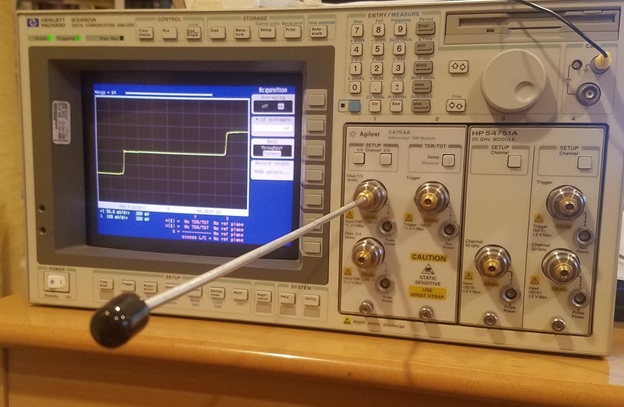
An old Hewlett-Packard mainframe with 20GHz TDR plug-in modules. This is the only permanent piece in the ‘lab’, sitting at the edge of the desk in my home office. I use it to check connectors and cables for possible wear and damage, also to sort cheap attenuators and other components that we can get by the bagful, to find the few decent parts.
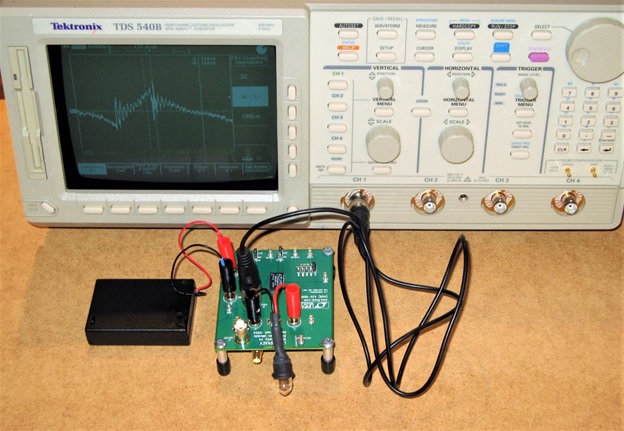
This is an even older Tektronix oscilloscope, a TDS 540B model with 2Gs/s sampling speed, 500MHz analog bandwidth. Though it has ‘only’ 8-bit digitizers, all four channels have a maximum sensitivity of 1 mV/div. One of the channels has a buffered output on the beck; it comes very handy when I need other instruments, too, to look at the same signal simultaneously.
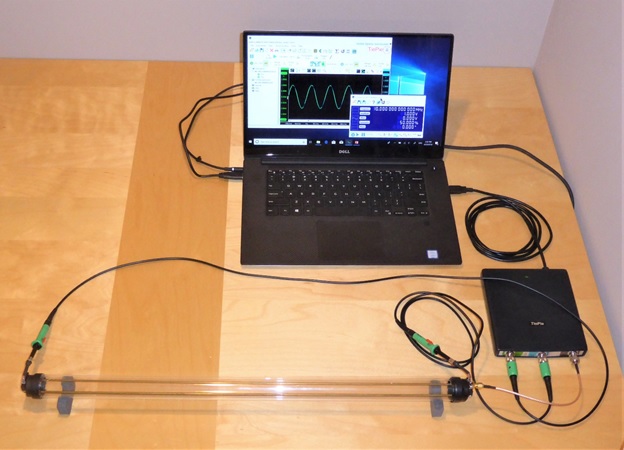
This image shows a newer TiePie oscilloscope model, HS5, with 500Ms/s sampling speed and 1uHz-40MHz arbitrary waveform generator, shown here as I prepare one of the transmission-line illustrations for my SI training courses.
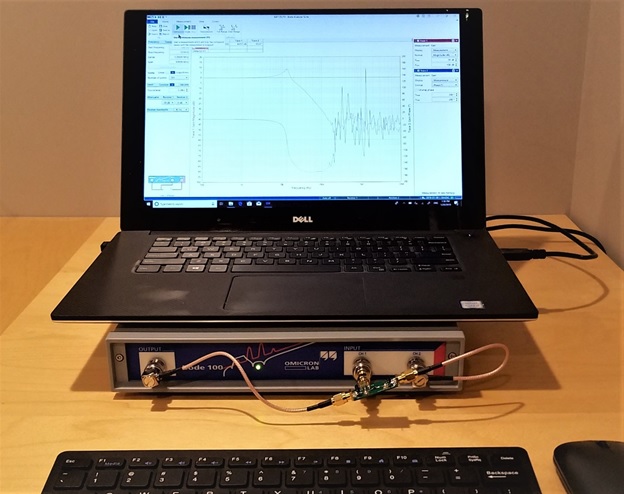
This was a temporary setup with an Omicron Bode 100 Frequency Response Analyzer, courtesy of Picotest, shown here in a setup measuring the transfer response of a PDN filter built on a little printed circuit board (attached to the middle BNC connector).

This is a setup to measure the control-loop stability of switching regulators. On the left is a HANMATEK HN305P 0-30V 0-5A bench power supply, on the right is a Keysight E5061B 5Hz – 3GHz network analyzer loaner, courtesy of Keysight. Just below the VNA screen, attached to the three BNC connectors is a home-made fixture to inject and sense the signals necessary for loop stability measurements. On the breadboard with a 9V battery connected is a home-made adjustable electronic load for up to a couple of amperes DC current.
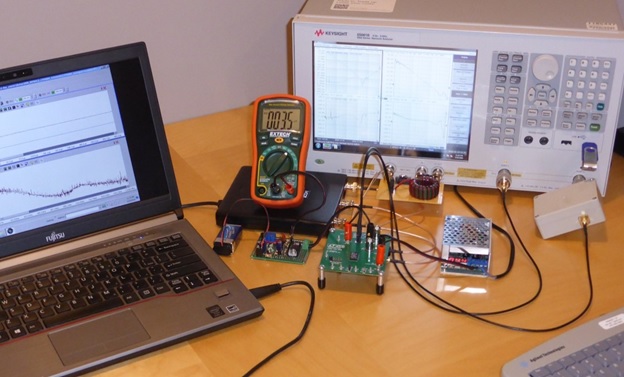
This is my favorite lab setup, illustrating the resilience of narrow-band frequency-domain measurements. On the right is a Keysight E5061B temporary loaner VNA, courtesy of Keysight. The device under test is the switching regulator demo board, the same that is shown in photo #3. It is powered from the small power supply in the perforated silver box. Three different tests are connected simultaneously to the switching regulator: output-impedance measurement with the S-parameter side of the VNA, gain-phase loop-stability measurement from the frequency-response analyzer side of the network analyzer, and a transient response test with the TiePie HS3 oscilloscope with its arbitrary waveform generator driving the built-in FET load of the switching regulator.

This image shows a current measurement setup with a temporary loaner E5061B network analyzer (courtesy of Keysight) with a Tektronix P6021 clamp-on current probe. The test signal is boosted with a Juntek DPA-2698 dual DC-10MHz power amplifier (this is the rectangular box -with striped top- connected to Port1 of the VNA), while the output signal of the current clamp is boosted with a Picotest J2180A-20 low-noise preamplifier loaner (courtesy of Picotest).
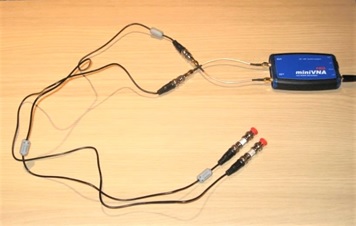
Finally, this one shows one of the permanent little VNAs in my lab that you can buy online: a miniVNA Pro two-port model from mini Radio Solutions. It covers the 100kHz – 200MHz frequency range. It is battery powered and can be controlled from a PC or phone, either through a USB cable or Bluetooth. Shown on the photo is a setup that can illustrate cable shield efficiency.
Istvan is a Principle Signal and Power Integrity Engineer at Samtec, working on advanced signal and power integrity designs and a member of the SIJ Editorial Advisory Board.
See Robert Haller's Lab on Next Page →
And, while he does not get to work from home, Robert Haller humored me with some images from the office:
Robert Haller: “I still have been going to the lab (occasionally) in the office, because it is impractical to move a thermal chamber and Ixia home, and not sure if the 25G scope traveled home I would bring it back!” Bob is senior principal hardware engineer at Extreme Networks.
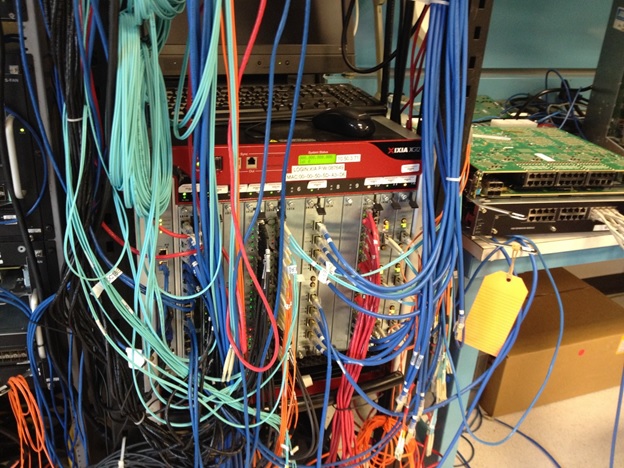
“Why I have to go into the office. I can’t bring the traffic generator (IXIA) home.”
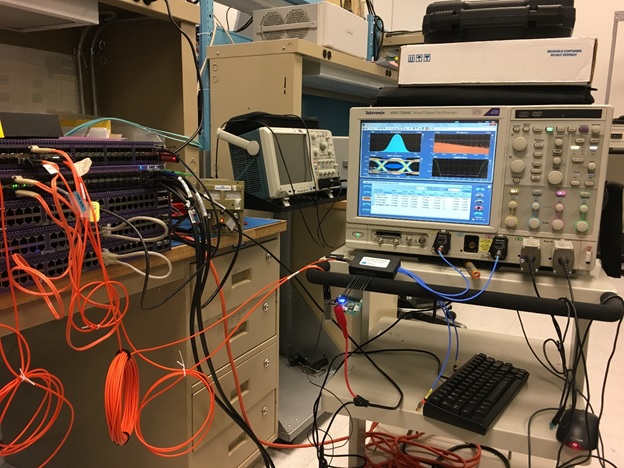
“If I bring my 20Ghz scope home, I will never go back to office.”

“That’s me helping the software guys debug optics issues (in SW area). Notice the wooden benches made for Cabletron by a local carpenter a million years ago. Also notice the Patriots shirt after we just won 5 Superbowls. A bunch of us Extreme folks get to go to every home game as “wi-Fi Coaches” including a select few to Superbowls ! Funny once a colleague and I commented that you can write an article around a single picture (worth a thousand words)…. 20G scope in foreground… I could keep going…”

“What not to do with your thermal chamber unless you want to cool down your beer.”
For help in planning your own home lab, check out the cover feature in the 2021 Signal Integrity Journal, “Low-Cost and Free Tools Fit for an Engineer’s Personal Budget,” written by Jay Diepenbrock and Eric Bogatin.

